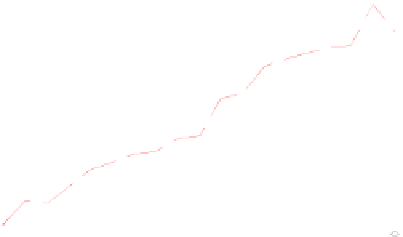Information Technology Reference
In-Depth Information
x
10
5
Throughput of Network
Network ex is t Selfis h-node
All c ommon nodes
3
2.8
2.6
2.4
2.2
2
1.8
1.6
2
4
6
8
10
12
14
16
18
20
22
Network size(node-number)
Fig. 5.
Throughput of network
As shown in Fig. 5, along with the network size increasing from 3 to 20, the
throughput of network increasing when none selfish node exist in the network. How-
ever, when there is one selfish node, the throughput hold steady.
P
a
cket loss rate
Network ex is t one S elfish node
Net work with all Common nodes
35
30
25
20
15
10
5
0
2
4
6
8
10
12
14
16
18
20
22
Network size(node-number)
Fig. 6.
Packet loss rate
In Fig. 6, when none selfish node exist, the packet loss rate show an upward trend
and amounts to 34% when the nodes amounts to 20. But when a selfish node exists,
along with the network size increasing, the packet loss rate change little, and always
keep in 1%.
2.3 Different Selfish Level Simulation
In this experiment, we analyze the impact of different selfish level on the network.
We define the ratio of the selfish behavior frequency to the backoff frequency in a
simulation as the selfish level and we introduce parameter P use to measure the selfish
level. When P=0, it means the process of simulation does not appear selfish behavior;
When P=1, it means the nodes are all selfish nodes which set their own BE as system
minimum value once sense the channel state is busy. There are 21 nodes in the














































































































































































































































































































































Search WWH ::

Custom Search